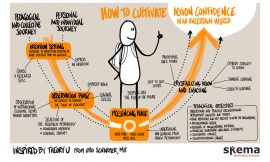After completely disrupting the daily lives of billions of humans, the pandemic continues to surprise us. At this stage, no one can say what will happen in the coming weeks.
Yet, we are all trying to figure out what tomorrow holds, either by making our own predictions or by listening intently to those made by others, particularly the experts. Our mental model has led us to believe that the only way to envisage the future is to predict it. Yet, research has long examined the question of how to decide on a course of action in the face of uncertainty, and has shown that this paradigm is far from inevitable.
New goals
One stream of research has studied the way we decide on our goals in order to take action. These goals we set are the reflection of how we envisage the future. Reflecting in this way on how we come up with new goals can shed some light on the way we approach the world of tomorrow.
One article in particular provides a fertile framework for re-examining this question. Entitled What to do next? The case for non-predictive strategy, it was published in 2006 in the Strategic Management Journal by Robert Wiltbank, Nicholas Dew, Stuart Read and Saras Sarasvathy.
According to these researchers, there are two major parameters guiding the approach we adopt when deciding what to do next. The first is prediction: I can think I’m able to predict the evolution of my environment (predictive paradigm) or, on the contrary, I can think I’m unable to predict it if, for example, I find myself in an uncertain environment.
The second parameter is control: I can either consider that I can influence the evolution of my environment or, on the contrary, that I cannot. By combining the two parameters, we obtain four possible attitudes:

These four situations can be detailed as follows:
- Situation 1: I think I can predict the future, but not influence it. It is therefore predetermined and I must anticipate it. The question that characterises this attitude is: given this future, “What must I do?” to ensure I have an optimal place in it.
- Situation 2: I think I can predict the future and influence my environment to ensure that future happens. The question is: “What do I want to do?”.
- Situation 3: I think I can neither predict the future nor influence it. I must accept my environment and adapt to survive. The question becomes: “How should I react to what is happening to me?”.
- Situation 4: I think that I cannot predict the future, but that this does not prevent me from influencing it. There is no ideal future, but I can take action, because the current situation provides means and resources. I can use to transform my present into an acceptable future. The question is: “What can I/we do with what I/we have?”
The attitude therefore stems from both our way of seeing the future, as something we must accept or something we can create, and how we view our present situation, i.e. do we see it as a constraint or as something that provides us with means and resources.
The example of a gym
There are now four attitudes possible for facing the future, rather than just the predictive approach. Let us look at how we can relate these to the COVID-19 pandemic.
Imagine a situation where the owner of a gym in the suburbs of Nice loses so many members that his business is now struggling to survive. As we know, the social distancing measures imposed during the lockdown and afterwards are still causing many problems for this particular industry.
If the owner takes an anticipated future approach (attitude 1), he will channel all his energy into figuring out what the future holds. For example, he will conduct market research and user surveys, run focus groups, and consult with experts. He might even create different scenarios. For example, studies may show that while the COVID risk persists customers want to exercise in larger spaces with private areas and air conditioning that includes an automatic disinfection system. The owner might then ask himself what changes he could make to his gym to meet this demand.
But by considering the three other approaches, he can expand his creative possibilities. If he takes a desired future approach (attitude 2), he is a visionary. He is able to look beyond the pandemic to what he desires for the future of sport. If he has a passion for new technologies, for example, he may decide that sport is a thing of the past and gamble everything on esports (online gaming).
If he takes an adaptative future approach (attitude 3), he will ask himself how to ensure his business can survive until the COVID situation is over. One possibility, for example, would be to temporarily hire out his gym to the restaurant next door, which needs more space in order to comply with the distancing requirements between tables. Any solution that allows him to survive is potentially acceptable.
Finally, if he takes the co-constructed future approach (attitude 4), the gym owner will ask himself what he can imagine from the present situation. For example, he could develop a combined offering with the restaurant owner next door, whereby he would share the latter’s outdoor area to set up his exercise machines outside (since the weather in Nice is conducive to this) and serve low-calorie meals that can be eaten on the go.
Generally speaking, neither one of these approaches is better than the others, except in times of uncertainty
Each of these four attitudes has advantages and disadvantages. The anticipated future approach is costly in terms of information gathering and resources needed. Getting the anticipated future approach wrong can have serious consequences.
The desired future approach focuses action but involves taking big risks; for example, esports might not catch on, and a rapid disappearance of the epidemic might lead to a sudden rush on indoor gyms. The adaptative future approach is a choice one makes under pressure when the goal is damage control. It is not very creative, but allows the business to stay afloat.
The co-created future approach is prudent. Its appeal lies in the fact that it does not require one to predict the future, and there is no need to know whether there will be a second even a third wave before implementing this choice, because whatever happens the result will be positive (combined offering with the restaurant owner). It therefore becomes a rational choice, given the climate of uncertainty. Moreover, it makes clever use of the resources available, by turning a crisis (COVID) into an opportunity.
In our experience we often find that, when faced with uncertainty, the reflex of managers is to try to predict more. This is no doubt reassuring for them, but it is illusory.
We have shown with a very simple model that there are three other worthwhile approaches to avoid becoming locked in to a predictive paradigm that is limiting and costly. Naturally, there is still a need for prediction and it remains useful, but these three additional approaches expand the range of options available to decision makers to become less fragile and, more importantly, to leverage uncertainty.
This article is republished from The Conversation under a Creative Commons licence. Read the original article.






